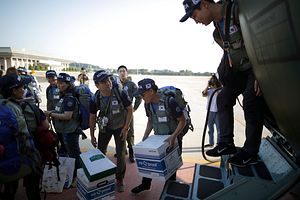After a dam collapse in Laos’ Attapeu province flooded 13 villages, leaving at least 19 people dead and 6,630 living in emergency shelters, two South Korean companies are facing questions of poor construction quality and criticized for being slow to respond to the emerging disaster.
On July 22, the Xe Pian-Xe Nam Noy dam collapsed, sending billions of cubic feet of water toward unsuspecting villages. The flood has caused severe damage to private property and infrastructure, and raised concerns about unexploded ordinance (UXO) that may have been dislodged by the water – according to the UN, at least 94 percent of villages in Attapeu province are known to have UXO.
The dam was part of a larger hydroelectric project in the region run by the Xe Pian Xe-Namnoy Power Company, a joint venture between South Korea’s SK Engineering & Construction (SK E&C) and Korea Western Power, along with Ratchaburi Electricity Generating Holding PCL of Thailand and the state-owned Lao Holding State Enterprise.
According to The New York Times, SK E&C discovered the initial damage on Sunday night, and the company said they immediately reported the issue to local authorities. The paper confirmed that the venture sent a further warning on Monday to provincial officials, informing them that the dam was in a “very dangerous condition now due to heavy rainfall,” and urging them to evacuate villagers.
As questions continue to swirl about the speed of response from both the companies and the local authorities, scrutiny has also turned to the construction quality of the dam project itself. Laotian Minister of Energy and Mines Khammany Inthirath suggested that the dam may have been built using “substandard construction.”
According to UPI, the dam was completed ahead of schedule and was set to begin full operations in February of 2019. Critics have pointed to the rushed schedule, as well as a failure to properly prepare for Laos’ annual rainy season, as possible causes for the collapse.
In South Korea, several civic groups called for the two Korean construction companies to be investigated and possibly held responsible for the incident. The National Assembly has even taken up the issue, bringing representatives from both SK C&E and Korea Western Power in for a hearing on the issue on July 25. There, the two companies raised different issues that may have caused the collapse, leading to criticisms that they were each pointing fingers at each other and avoiding responsibility for the disaster.
Meanwhile, the South Korean government has stepped in to assist with recovery efforts. On July 29, a team of Korean medical personnel arrived to help provide assistance to victims in the region. “This accident took place at a dam project in Laos which a Korean company was part of. Not only are the eyes of the locals in Laos on you, the citizens of Korea are also interested in our rescue efforts,” said Kang Jeong-sik, deputy minister for multilateral and global affairs at Korea’s Ministry of Foreign Affairs, as the medics prepared to head to the affected region. The government also plans to send $500,000 in supplies and $500,000 in cash to help with disaster relief efforts.
On July 27, SK Group Chairman Chey Tae-won, who runs the parent company of SK E&C, visited the Lao Embassy in Seoul to express condolences. He also delivered $10 million to help with the recovery along with dedicating 200 personnel to help deliver emergency supplies to victims. Korea Western Power also sent $1 million to the local provincial government, and Korean Air, which was not directly involved in the project, donated 40 tons of emergency aid kits.
While the two Korean companies in question as well as Lao authorities will continue to face questions as the official investigation into the incident gets underway, the focus at the moment is on finding additional victims and ensuring that people in the area have access to emergency resources. According to an SK E&C official, “Nothing has been confirmed as the cause of the dam collapse. We believe the rescue operation and assisting flood recovery must be prioritized at this stage… Finding the exact cause of the accident will be conducted separately.”
Jenna Gibson is the Director of Communications at The Korea Economic Institute of America. You can follow Jenna on Twitter at @jennargibson.
































